
Bohemia is the westernmost and largest historical region of the Czech Republic. Bohemia can also refer to a wider area consisting of the historical Lands of the Bohemian Crown ruled by the Bohemian kings, including Moravia and Czech Silesia, in which case the smaller region is referred to as Bohemia proper as a means of distinction.
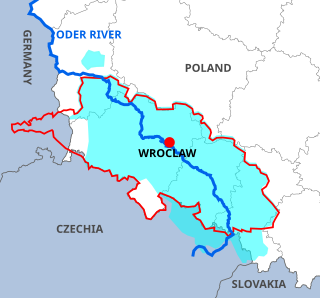
Silesia is a historical region of Central Europe that lies mostly within Poland, with small parts in the Czech Republic and Germany. Its area is approximately 40,000 km2 (15,400 sq mi), and the population is estimated at around 8,000,000. Silesia is split into two main subregions, Lower Silesia in the west and Upper Silesia in the east. Silesia has a diverse culture, including architecture, costumes, cuisine, traditions, and the Silesian language.

Linz is the capital of Upper Austria and third-largest city in Austria. In the north of the country, it is on the Danube 30 km (19 mi), south of the Czech border. In 2018, the population was 204,846.

Upper Austria is one of the nine states or Länder of Austria. Its capital is Linz. Upper Austria borders Germany and the Czech Republic, as well as the other Austrian states of Lower Austria, Styria, and Salzburg. With an area of 11,982 km2 (4,626 sq mi) and 1.49 million inhabitants, Upper Austria is the fourth-largest Austrian state by land area and the third-largest by population.

Lower Austria is one of the nine states of Austria, located in the northeastern corner of the country. Since 1986, the capital of Lower Austria has been Sankt Pölten, replacing Vienna which became a separate state in 1921. With a land area of 19,186 km2 (7,408 sq mi) and a population of 1.685 million people, Lower Austria is the second-most populous state in Austria. Other large cities are Amstetten, Klosterneuburg, Krems an der Donau, Stockerau and Wiener Neustadt.

Bavarian or alternately Austro-Bavarian, is a West Germanic language consisting of a group of dialects, part of the Upper German family, together with Alemannic and East Franconian.
Fugging, spelt Fucking until 2021, is an Austrian village in the municipality of Tarsdorf, located in the Innviertel region of western Upper Austria. It is 33 km (21 mi) north of Salzburg and 4
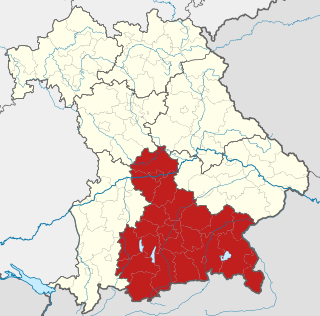
Upper Bavaria is one of the seven administrative districts of Bavaria, Germany.

Austria is a federal republic made up of nine provinces. Since Land is also the German word for "country", the term Bundesländer is often used instead to avoid ambiguity. The Constitution of Austria uses both terms. Austrian provinces can pass laws that stay within the limits of the constitution, and each province has representatives in the main Austrian parliament.

The Greens – The Green Alternative is a green political party in Austria.
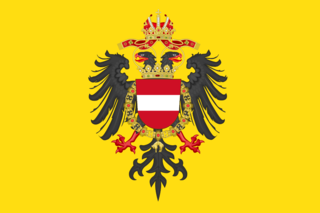
The Habsburg monarchy, also known as the Danubian monarchy, or Habsburg Empire, was the collection of empires, kingdoms, duchies, counties and other polities that were ruled by the House of Habsburg, especially the dynasty's Austrian branch.
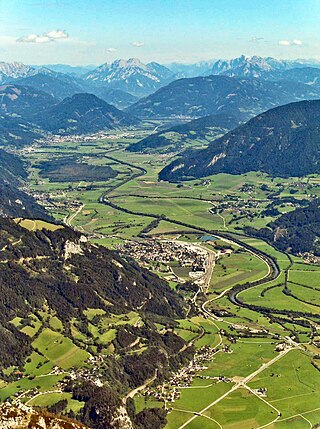
The Enns is a southern tributary of the river Danube, joining northward at Enns, Austria. It forms much of the border between the states of Lower Austria and Upper Austria. The Enns spans 253 kilometres (157 mi), in a flat-J-shape. It flows from its source near the village Flachau, generally eastward through Radstadt, Schladming, and Liezen, then turns north near Hieflau, to flow past Weyer and Ternberg through Steyr, and further north to the Danube at Enns.

Gau is a Germanic term for a region within a country, often a former or current province. It was used in the Middle Ages, when it can be seen as roughly corresponding to an English shire. The administrative use of the term was revived as a subdivision during the period of Nazi Germany in 1933–1945. It still appears today in regional names, such as the Rheingau or Allgäu.

The Austrian Football Bundesliga, also known as Admiral Bundesliga for sponsorship reasons, is the top level of the Austrian football league system. The competition decides the Austrian national football champions, as well the country's entrants for the various European cups run by UEFA. Since Austria stayed in sixteenth place in the UEFA association coefficient rankings at the end of the 2015–16 season, the league gained its first spot for the UEFA Champions League for the 2016–17 season.

Bad Hall is a market town in the Steyr-Land district of the Austrian state of Upper Austria. Its name, Bad Hall, means "salt bath," a reference to its long history of baths and spas. It is renowned for its saline springs, strongly impregnated with iodine and bromine. Although the springs have been known since the 8th century, Hall has been noted for them only since 1855, when the springs became the property of the government.

FC Juniors OÖ is an Austrian association football club, from Pasching, Upper Austria. It was newly founded after the move of ASKÖ Pasching, who last appeared as FC Superfund, to Carinthia and the associated renaming in SK Austria Kärnten in 2007 as FC Superfund Pasching. The greatest success of the club is winning the ÖFB-Cup as the first third division in the history of the competition in the 2012–13 season and the associated qualification for the play-offs of the 2013–14 UEFA Europa League, in which the club was however defeated by Estoril Praia.
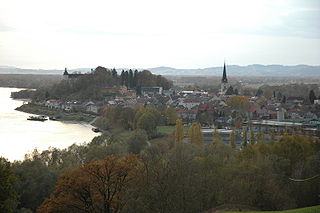
Ottensheim is a municipality in the district of Urfahr-Umgebung in the Austrian state of Upper Austria. In July 2008 it hosted the World Rowing Championships, and it did so again in 2019.

The 2011–12 Austrian Football Bundesliga was the 100th season of top-tier football in Austria and was contested by ten teams. The Austrian football champion was determined in four heats. The championship began on 16 July 2011 and ended on 17 May 2012 with the completion of the 36th and final round.

Raiffeisenlandesbank Oberösterreich AG is a credit institution and grouping of cooperative banks founded in the 1900s and headquartered in Linz, Austria. It is the central institution of the Raiffeisen Banking Group in Upper Austria and the largest of Austria's eight provincial central banks.



















